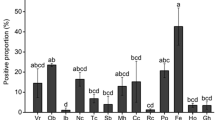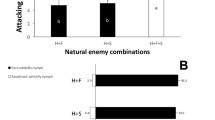Two methods were employed to assess the potential of candidate parasitoid species/strains to parasitize B. tabaci under field conditions in Texas. Sleeve cage evaluations were conducted in kale, cantaloupe melons, and cotton in 1994–1995. In kale, the highest parasitism rates were observed for two strains of Eret. mundus (Spain M92014, and India M92019). Similar evaluations in cantaloupe melons identified Eret. mundus (Spain M92014) and Enc. sp. nr. pergandiella (Brazil M94055) as parasitizing the greatest numbers of B. tabaci. Sleeve cage evaluations in cotton showed that Eret. hayati (Pakistan M5012) and two Eret. mundus strains (Spain M92014, and India M92019) parasitized the most whitefly hosts.
Open field release evaluations were conducted in cotton, broccoli and cantaloupe in 1995–1996 on species or strains of parasitoids that performed well in sleeve cage evaluations. Field release evaluations in cotton showed that Eret. mundus (Spain M2014) and Eret. hayati (India M93005) were regularly recovered, but they did not parasitize more hosts than the native Eret. tejanus or Enc. pergandiella. This may have been due to an ‘incumbent advantage’ of greater numbers of native parasitoid present during the releases of exotic parasitoids. Field releases of Eret. mundus (Spain M92014) in winter broccoli showed higher parasitism rates than either of the native parasitoids. Evaluations of Eret. mundus (Spain M92014) and Eret. hayati (Pakistan M95012) in cantaloupe showed higher parasitism rates than the native Eret. tejanus and Enc. pergandiella.
Subsequent parasitoid recovery studies conducted in 2001 through 2004 showed repeated collection of Eret. hayati (Pakistan M95012) across all crop types sampled. A small number of Eret. mundus (Spain M92014) were recovered as well, principally from cole crops. During collections made in 2005, Eret. hayati (Pakistan M95012) was again collected in large numbers for export to combat B. tabaci in Australia. These findings indicate that Eret hayati has become well established in the LRGV of Texas.
Access this chapter
Tax calculation will be finalised at checkout
Purchases are for personal use only
Preview
Unable to display preview. Download preview PDF.
Similar content being viewed by others
References
Goolsby, J.A., J.C. Legaspi, and B.C. Legaspi, Jr. 1996. Quarantine evaluation of exotic parasitoids of the sweetpotato whitefly, Bemisia tabaci (Gennadius). Southwestern Entomologist 21: 13–21.
Goolsby, J.A., M.A. Ciomperlik, B.C. Legaspi, Jr., J.C. Legaspi, and L.E. Wendel. 1998. Laboratory and field evaluation of exotic parasitoids of Bemisia tabaci (Gennadius) (Biotype “B”) (Hymenoptera: Aleyrodidae) in the Lower Rio Grande Valley of Texas. Biological Control 12: 127–135.
Goolsby, J.A., M.A. Ciomperlik, A.A. Kirk, W.A. Jones, B.C. Legaspi, R.A. Ruiz, D.C. Vacek, and L.E. Wendel. 2000. Predictive and empirical evaluation for parasitoids of Bemisia tabaci (Biotype “B”), based on morphological and molecular systematics. In A. Austin and M. Dowton, eds., Hymenoptera: Evolution, Biodiversity, and Biological Control, pp. 347–358. Fourth International Hymenopterists Conference, 6–11 January 1999, Canberra, ACT, Australia, CSIRO Publishing, Collingwood, Victoria.
Goolsby, J.A., P. J. De Barro, A.A. Kirk, R. Sutherst, L. Canas, M. Ciomperlik, P. Ellsworth, J. Gould, K.A. Hoelmer, S. J. Naranjo, M. Rose, W. Roltsch, R. Ruiz, C. Pickett, and D. Vacek. 2005. Post-release evaluation of the biological control of Bemisia tabaci biotype “B” in the USA and the development of predictive tools to guide introductions for other countries. Biological Control 32: 70–77.
Riley, D.G. and M.A. Ciomperlik. 1997. Whitefly (Homoptera: Aleyrodidae) and associated parasitoid (Hymenoptera: Aphelinidae) population dynamics in the Lower Rio Grande Valley of Texas. Environmental Entomology 26: 1049–1055.
SAS Institute, Inc. 1995. SAS/STAT users guide. Statistical Analysis System Institute, Cary, NC.
Author information
Authors and Affiliations
Editor information
Editors and Affiliations
Rights and permissions
Copyright information
© 2008 Springer Science + Business Media B.V
About this chapter
Cite this chapter
Ciomperlik, M.A., Goolsby, J. (2008). Field Evaluation of Bemisia Parasitoids in Texas. In: Gould, J., Hoelmer, K., Goolsby, J. (eds) Classical Biological Control of Bemisia tabaci in the United States - A Review of Interagency Research and Implementation. Progress in Biological Control, vol 4. Springer, Dordrecht. https://doi.org/10.1007/978-1-4020-6740-2_9
Download citation
DOI: https://doi.org/10.1007/978-1-4020-6740-2_9
Publisher Name: Springer, Dordrecht
Print ISBN: 978-1-4020-6739-6
Online ISBN: 978-1-4020-6740-2
eBook Packages: Biomedical and Life SciencesBiomedical and Life Sciences (R0)




